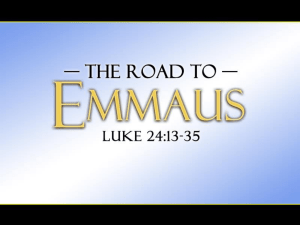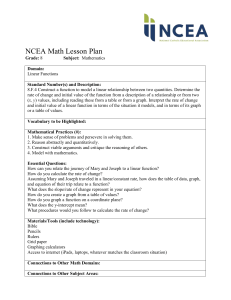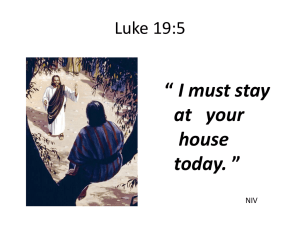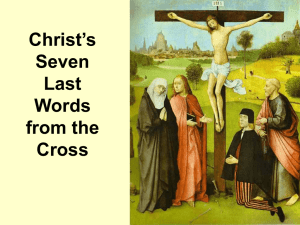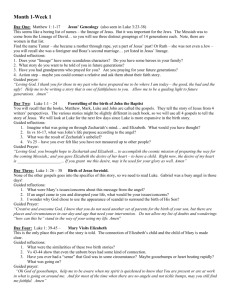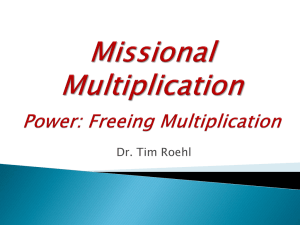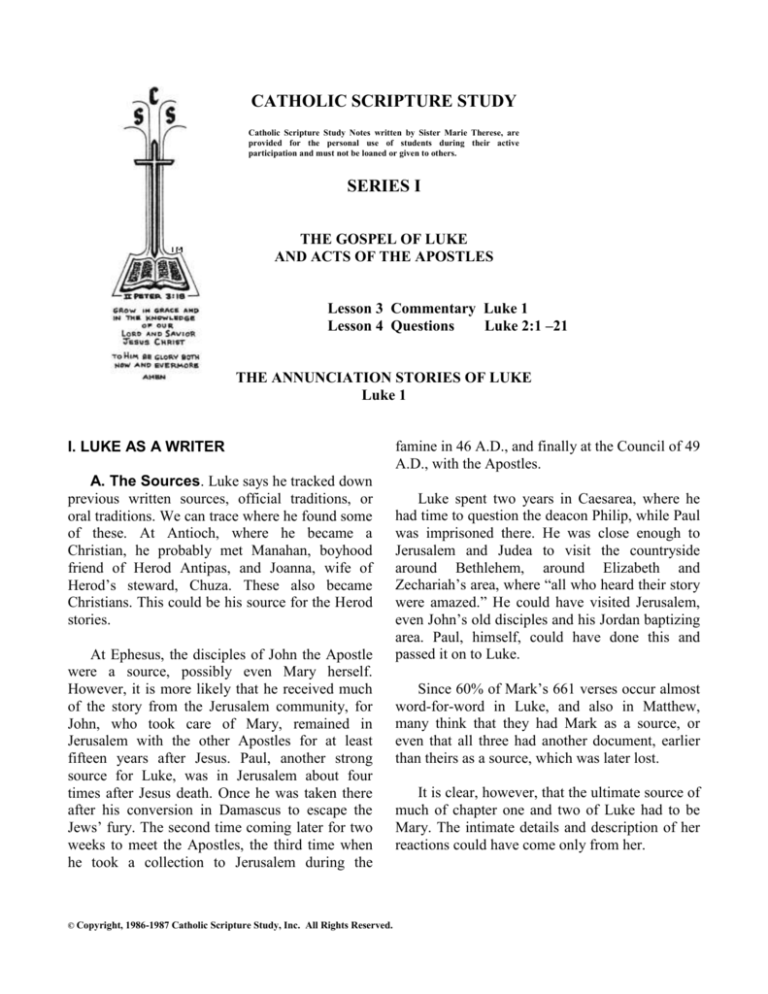
CATHOLIC SCRIPTURE STUDY
Catholic Scripture Study Notes written by Sister Marie Therese, are
provided for the personal use of students during their active
participation and must not be loaned or given to others.
SERIES I
THE GOSPEL OF LUKE
AND ACTS OF THE APOSTLES
Lesson 3 Commentary Luke 1
Lesson 4 Questions
Luke 2:1 –21
THE ANNUNCIATION STORIES OF LUKE
Luke 1
I. LUKE AS A WRITER
A. The Sources. Luke says he tracked down
previous written sources, official traditions, or
oral traditions. We can trace where he found some
of these. At Antioch, where he became a
Christian, he probably met Manahan, boyhood
friend of Herod Antipas, and Joanna, wife of
Herod’s steward, Chuza. These also became
Christians. This could be his source for the Herod
stories.
At Ephesus, the disciples of John the Apostle
were a source, possibly even Mary herself.
However, it is more likely that he received much
of the story from the Jerusalem community, for
John, who took care of Mary, remained in
Jerusalem with the other Apostles for at least
fifteen years after Jesus. Paul, another strong
source for Luke, was in Jerusalem about four
times after Jesus death. Once he was taken there
after his conversion in Damascus to escape the
Jews’ fury. The second time coming later for two
weeks to meet the Apostles, the third time when
he took a collection to Jerusalem during the
© Copyright, 1986-1987 Catholic Scripture Study, Inc. All Rights Reserved.
famine in 46 A.D., and finally at the Council of 49
A.D., with the Apostles.
Luke spent two years in Caesarea, where he
had time to question the deacon Philip, while Paul
was imprisoned there. He was close enough to
Jerusalem and Judea to visit the countryside
around Bethlehem, around Elizabeth and
Zechariah’s area, where “all who heard their story
were amazed.” He could have visited Jerusalem,
even John’s old disciples and his Jordan baptizing
area. Paul, himself, could have done this and
passed it on to Luke.
Since 60% of Mark’s 661 verses occur almost
word-for-word in Luke, and also in Matthew,
many think that they had Mark as a source, or
even that all three had another document, earlier
than theirs as a source, which was later lost.
It is clear, however, that the ultimate source of
much of chapter one and two of Luke had to be
Mary. The intimate details and description of her
reactions could have come only from her.
Series I
Scholars have noted the strong similarity
between the Infancy narrative and the Pentecost
story, both written by Luke, and both describing
the birth of Christ, and the birth of His Church. In
both, Mary is named and the Holy Spirit came
powerfully to bring into being the Messianic age.
From this parallel (a favorite device of Hebrew
writers) comes the view of Mary as mother of the
Church, as well as of Jesus, its founder. She is
also seen from these stories as the first believer,
the first Christian.
It has also long been thought that the source of
these stories was the Jerusalem post-Pentecostal
community in which Mary had lived, and that she
was so understanding of the Christians’ desire to
know Jesus that she shared with them her special
knowledge of His infancy and upbringing.
Some scholars believe that Luke wrote his
Gospel around 62 A.D. when Paul was
imprisoned in Caesarea, north of Galilee; others
during Paul’s Roman captivity, which would
make it later.
B. The Structure. The Infancy section is
like a diptych with seven episodes, presented in
two phases set up in this scheme:
1. Before the births, three episodes:
Announcement of John’s Birth, Announcement of
Jesus’ Birth, and a complementary episode, the
Visitation.
2. Births, four episodes: Birth of John, of
Jesus, Circumcision, Finding in the Temple.
C. The Style. Luke’s style is hymnal,
doctrinal, and meditative. His Gospel has an
atmosphere of peace, joy, prayer, and union with
God. In the Infancy narrative, it is that of a private
tradition, or a popular tradition, and has the
earmarks of a miniature Gospel. There is
definitely a Jewish background with an emphasis
on redemption, long expected by the Jews. The
parallelism is a Jewish literary habit. Some
Lesson 3
Page 2
conclude that this originated as a written
document which Luke studied and from which he
absorbed its Semitic (Hebrew) style, such as the
assonance of Messiah and Savior in the original
Hebrew.
There is theology in the Infancy narrative
based on episodes—fact, for Luke claims his
account is history. But these facts he associates
and interprets in the light of Old Testament texts
that either he, a Greek, found in the Septuagint
(the Greek translation of the Old Testament), or
which Paul had found and Luke incorporates. We
will see some of these when we discuss the
Infancy narratives.
It is also clear that Luke is writing for nonJews, as He explains Jewish terms which Jews
would know; he omits what would offend Gentile
readers, and some violent scenes, for instance, the
murder of John the Baptist.
The Infancy narratives, though some scholars
have thought so, are not midrash (a scripture text
followed by interpretative application by Jewish
rabbis), nor haggadah (fictional stories explaining
the law of Jewish faith or morals). They are, says
Luke, “events which have been fulfilled in our
midst” which he claims for his Gospel in the
introduction. Though the angel, for instance,
could be a genuine spiritual experience presented
by Luke in a traditional and consecrated style,
some scholars note that the angel is named as he
is in Daniel 10. This seems more supportive of a
being who is real, in a real episode.
The Canticles in the Infancy narratives are
found in several Old Testament texts leading
scholars to think that they were meant to bring out
the spiritual significance of the episode he has just
told. It is unlikely that word-for-word they were
remembered by someone who said or heard them,
but they do express Zechariah’s remembered
reactions and Mary’s feelings and her very real
knowledge of Jewish scripture and faith; and of
course, they are inspired by God who spoke
Series I
through Zechariah, Mary, and Luke. The first
lines of Mary’s Canticle regarding herself, and the
last ones of Zechariah regarding his child, are
very likely the base and the authentic words of the
account Luke received.
II. ANNOUNCEMENT OF THE BIRTH OF
JOHN
A. A Childless Couple (Luke 1:5-7).
Luke alone gives this infancy story of John. He
situates it in history and in a genealogy. The priest
Zechariah was one of the Abijah class, that is, a
descendant of the 24 grandsons of Aaron, as was
Elizabeth, his wife. They were holy Israelites
“blamelessly following all the commandments of
the Lord.” Like Abraham and Sarah, they were
advanced in years, and Elizabeth had had no
children. This was called “sterile” in relation to
the woman; today, of course, we know that either
of the couple could be sterile to cause no birth to
them. All Jewish women considered it a disgrace
not to bear a child to further the family line and
the People of God.
Elizabeth is thus like the other God-fearing
women in the Scriptures, and as the story
advances, she is also like them in God’s
intervention. Sarah, Abraham’s wife (Genesis
17:15-19), Samson’s mother (Judges 13:2-25),
Samuel’s mother (1 Samuel 1:1-27), were all
praying for a child, and received a son who was
special to Israel, as did Elizabeth.
Luke begins the Infancy narrative with
Zechariah’s turn of a week’s service as a priest in
the Temple. Thus the infancy narrative begins and
ends in the Temple, as we shall see. We can
imagine the holy old man feeling awed and proud
as he alone steps into the Holy Place and offers
incense, while the “full assembly of people” stood
outside. Zechariah was “deeply disturbed at the
sight” of the angel and, as is usual with humans in
contact with heavenly beings or God, was
“overcome by fear.” There are reminders of
Daniel here (Daniel 10:8-12) when the prophet
Lesson 3
Page 3
Daniel saw the same angel, who names himself
then as he did to Zechariah, and revealed the time
to expect the coming Messiah, so both refer to the
opening of the Messianic age.
B. Zechariah and the Angel Gabriel
(Luke 1:8-25). The angel Gabriel, however,
speaks plainly to Zechariah, “Your wife will bear
a son whom you shall name John (Yahweh has
shown favor). The prophetic news of the greatness
of John comes to Zechariah in the words, “Many
will rejoice at his birth.”
Then Gabriel tells words about John similar to
Samson’s characteristics: “a Nazarite who will not
drink strong drink, but instead will be filled with
the Holy Spirit.” The last phrase is a Biblical way
of identifying a prophet or prophecy. John will be
that “from his mother’s womb” which the
visitation of Jesus in Mary will bring about.
His role is then described further by the angel,
as similar to that of the great prophet Elijah whom
the Jews always expected to return. Jesus later
remarked that John was greater than Elijah, and
that no man born to woman was greater! Clearly,
He was leaving Himself out as a man, and more
than a man.
Now Zechariah begins to question, and not
wisely, for he seems to doubt the prophecy, and is
gently but firmly told that he will not speak
further until the prophecy is fulfilled.
After he returned home, Elizabeth conceived
and went into seclusion. Whether this was custom,
or that she was so overwhelmed with joy and yet
embarrassment at Zechariah’s sudden inability to
speak or hear, we do not know. What must this
holy couple’s home have been like, in these
months of silence and retreat? We can believe that
they were often in prayer there and pondering on
the meaning and words of God, and growing
closer to God as the child grew in the womb. It is
easy to see the great contrast in this older woman,
so wanting a child, and some of today’s fears and
Series I
Lesson 3
Page 4
rejection of pregnancy at any time, much less in
older years.
Mary’s perfect cooperation with God and her Son,
led her to preserve sinlessness.
III. ANNOUNCEMENT OF THE BIRTH OF
JESUS
B. Mary and the Angel (Luke 1:34-38).
Mary’s beautiful and humble response to this
unusual greeting arose from her profound and
simple awareness of herself in comparison to the
God of majesty whom she, of all humans, must
have known intimately. It is said of saints that the
more they understand God, the less they think of
themselves; they see their nothingness and
dependence and marvel at His love for them.
Something of this must have arisen in Mary in the
presence of the angel from God, with this praise; a
presence that in itself was awe-inspiring. Yet it
was more than awe and fear, for Mary was
troubled at his words, puzzled at the meaning of
such praise. This lack of expectation of any praise
was the cause, it is thought, of God’s favor, for He
is attracted by humility and truth, so rare among
His creatures, infected by pride.
A. Gabriel’s Greeting to Mary (Luke
1:26-33). Though Elizabeth did not know it,
during this time, the same angel is sent to earth
again to a Galilean insignificant village, to a
maiden not yet married and living in her own
home, but betrothed to a man named Joseph of the
house of David (Matthew 1:5-6 and Isaiah 11:15). “The Virgin’s name was Mary”—Miriam in
Hebrew and common then. Luke has twice used
the word virgin here.
Gabriel’s words in saluting Mary and telling
his news include the most impressive salutation in
the Bible, and are echoes of many Old Testament
texts which all devout Hebrews knew.
The Greek “charis” used here, “highly gifted
or favored, adorned” means that Mary is “par
excellence” in God’s eyes. She is “most favored,”
the permanent object of God’s predilection. So
she was full of His gifts—there was no shadow of
sin that could mar her in His eyes.
Twice the angel mentions that she is blessed
among women, as does Elizabeth later. Such
terms were never heard before in Scripture.
This beautiful and unusual greeting is the
source of the insight, aided by the Holy Spirit, of
the belief that Mary’s soul was preserved from
original sin, by reason of her Son’s dignity and
merits. We call this grace the Immaculate
Conception. Mary, as Eve was in the beginning,
was created without sin. But like Eve, she had free
will. We must realize that being created without
sin did not mean she could not sin. The sensum
fidei and the Magisterium, led by the Christians of
the first and second centuries, especially the
doctors of the Church, who discussed and finally
accepted this insight, have always believed that
Gently the angel calmed her fear and again, as
to Elizabeth, announces the conception of a son,
and His name—Jesus (the salvation of God); then
he goes on to announce the Messiah, the expected
Son of David, the ruler of Jacob’s house forever;
Jacob—Abraham’s grandson and father of the
patriarchs of the twelve tribes. He added that
Mary’s son would even be called “Son of the most
High!” It is amazing that Mary was not
completely overwhelmed at such Scriptural
messages about her son. But she remembered that
God has already asked a gift from her, and she
calmly asked a question that causes many another
question.
“How can this be done since I do not know
man?” For an engaged girl to ask this shows that
she had a concern about which she prudently
needed an answer—a difficulty out of the
ordinary. Her Semitic statement, “I do not know
man” would be unreal otherwise. She did not
expect, apparently, to be a mother. This question
suggested to first and second century Christians
that Mary was so aware of God, her love was so
Series I
Lesson 3
Page 5
special, that she had an exclusive love for Him.
This kind of love was described in the Old
Testament in such texts as Deuteronomy 6:5,
Hosea 2:16-18; 21-22, and in the Psalms and
Prophets. It found its culmination in Mary, the
first Christian, and the first of a long line of
Christians who felt called to virginity in response
to such an interior grace. It has been preserved in
traditional religious life, and also, in modern lay
people who make privately one or other of the
vows.
And the words of Mary came without any
further hesitation: “I am the handmaid (double—
female slave, one completely at the service of a
master) of the LORD!” And her next words
ushered in the moment that changed the way the
world counted time—New Testament history
began. Mary believed the angel and said, “Let it
be done to me as you say.” God waited for a free
response of a girl of fourteen and created the
small cell of a little being with a human nature in
time, and a divine nature from eternity.
This early Christian belief is preserved in the
Apostles Creed, (“born of the Virgin Mary”), in
the Nicene Creed (Council of NiceaConstantinople, 381 A.D.), and in the liturgy and
feasts of the Church from earliest times. The
Eucharistic Prayer of the Mass, quite ancient, says
“We honor Mary, the ever-virgin mother of Jesus
Christ our Lord and God.”
Mary’s humble obedience to a change in her
plans was in total contrast to the disobedience of
the mother of our race. Mary became the second
Eve, as Jesus was the second Adam, both
repairing what was spoiled by the first.
IV. WOMAN OF FAITH
B. The Visitation. Mary thinks of Elizabeth
and hastily goes to be of assistance. She may
rightfully also have wanted someone to share
with, to seek advice. She received a surprise that
overjoyed her.
A. When the angel told her of God’s spirit
overshadowing her, we have another strong Old
Testament image, for Luke’s word is the same as
that used for the Presence of God that hovered
over the Ark of the Covenant (Exodus 40:34-38).
And Mary was more the Ark of the Covenant than
the original one! Did Mary interpret the words
“Son of the Most High” and “Son of God,” both
used by the angel, as we do? Did she clearly
realize the little boy to come was, as we say, the
second Person of God? Probably not that clearly.
She was a woman of faith as we are, and as these
mysteries were revealed to her, she, like the
Church does, pondered them, sought to place
them in the context of other revelations, and thus
grew in understanding.
At Mary’s greeting, Elizabeth cried out with a
loud voice and was “filled with the Holy Spirit.”
This is the first time Luke uses this phrase in his
writings. And Elizabeth utters the first beatitude
in the Gospel: “Blessed is she who believed that
the Lord’s words to her would be fulfilled.” She
also uses the same greeting that the angel did:
“Blessed are you among women.” In this greeting,
Elizabeth also effaces herself before Mary as John
her son later does before Jesus, and as David did
before the Ark of the Covenant (2 Samuel 6:9).
John, at the same time, already in the womb of his
mother, is sanctified by Jesus and leaps with joy
at the sound of Mary’s voice. Here Luke is noting
that through Mary, Jesus brought joy to the world.
As a help to Mary’s faith, and to her more
complete knowledge of God’s great promises
unfolding rapidly around her, the angel tells her
that Elizabeth, her older relative, is six months
with child, for “nothing is impossible with God”
(Luke 1:37).
Elizabeth also calls Mary the mother of my
Lord,” causing some question about whether
Elizabeth meant mother of God? This also is
where Mary’s great faith and her role as a woman
of faith, is shown. The Gospel says several times
that Mary “did not understand”—“pondered.”
Series I
Lesson 3
Page 6
She, too, had to question at times before the
revelation was clear to her. She is our mother in
the faith, too. This aspect of Mary is given much
emphasis in modern times to counteract some
excessive piety of the past which made Mary a
frail, weak-looking, Hollywood-made-up-in-her
beauty woman, who knew everything and had no
reason for faith. How then, could she be mother of
the believing Church?
C.
The
“Magnificat”—”My
Soul
Glorifies the Lord.” In the reply to Elizabeth,
Luke begins Mary’s sublime words of praise and
joy at the “greatness of the Lord” and her joy in
Him who regarded her “lowliness.” We get a
glimpse here of Mary’s spirituality, her soul,
which Luke had learned about from her or from
one of his sources. This sublime and biblical
hymn of praise, full of Old Testament allusions, is
almost exactly found in 1 Samuel 2:1-10, as
exclaimed by Hannah, the mother of Samuel.
Mary may have known it by heart practically, or
Luke must have incorporated it in his canticle, a
poetic song, as fitting Mary better than any other
description. This song reveals “the beautiful soul
of the Jewish maiden who first uttered this Gospel
of salvation in the poetry of her native tongue”
(Carroll Stuhlmeuller, C.P.). Latin American
parishes and communities, sing Mary’s song
remembering the old themes she knew from the
prophets. Her song is also recited or sung in every
daily Vespers in the Divine Office of the Church.
littleness made her say very meekly to Gabriel:
“Behold me here; God’s handmaiden” (JULIAN,
WOMAN OF OUR DAY, p. 14, Chapter 4, p.
182).
D. Birth of John the Baptist (Luke 1:5780). Luke mentions, to close his scene, that Mary
remained about three months with Elizabeth.
Many believe that this includes the birth and the
circumcision of John, in which Zechariah was
healed of his inability to speak when he wrote the
child’s name. “And throughout the hill country,”
says Luke, “these happenings began to be
recounted to the last detail.” And Luke must have
found them out there.
At last, it was time for Zechariah to be “filled
with the Holy Spirit” (of prophecy), and he too,
has a very Biblically oriented song of praise. This
one, like Mary’s, is said every day, and has been
for centuries, by all who say the Divine Office,
now called the “Hours of the Day,” every day.
The Sisters gather in chapel for Vespers each day.
The “Magnificat” of Mary, which is said or sung,
is in its closing. Vespers belongs to the whole
people of the Church and many say this daily, too.
With Mary gone home to Nazareth, Luke
concludes Chapter 1 with John’s growing up and
maturing in spirit, and his call to the desert where
he will be preaching when we next hear of him.
In one of Juliana of Norwich’s revelations she
says, “God showed me the wisdom and truth of
Mary’s soul. In this, I understood the reverent
contemplation with which she beheld her God,
who is her Creator, marveling with great
reverence that He was willing to be born of her
who was a simple creature created by Him. And
this wisdom and truth, this knowledge of her
Creator’s greatness and of her own created
*******
Series I
Lesson 3
Page 7
QUESTIONS FOR LESSON 4
Luke 2:1-21
Day 1
Read the Notes and the references in them to other Bible passages.
Day 2
Choose a passage from the notes and a reference in the Bible. Share with the group, and tell
why it struck you especially.
Day 3
Read Luke 2:1-7.
a. What type of birth experiences or situations did God plan for Jesus, (since it was the
Godhead in Jesus that planned His own birth as man)?
b. What do you learn about the situations of Joseph and Mary? Their virtues?
Day 4
Read Luke 2:8-20.
a. What striking difference is there in the events told in Luke 2:1-7 and 2:8-14?
b. What do we learn from these first events in Jesus’ life for our lives; for instance in regard to
poverty and affluence?
Series I
Lesson 3
Page 8
c. What do we learn about God in Luke 2:1-14?
Day 5
Read Luke 2:15-20.
a. What kind of people did God call first to His son? Does this pattern continue during Jesus’
life? What do you learn about God from this?
b. From what you already know about Jesus’ life, what other facts show the same pattern?
c. What does this pattern for Jesus’ life teach you?
Day 6
a. What do you learn of Mary in Luke 2:19?
b. Contrast these simple events with our celebration of Christmas. Reflect on your own and
your family’s understanding and celebration of this birthday.

